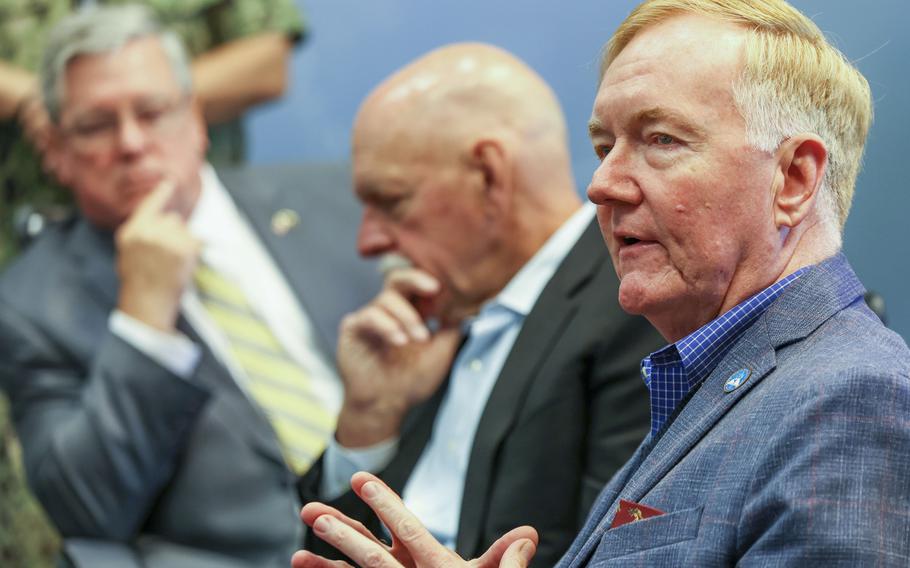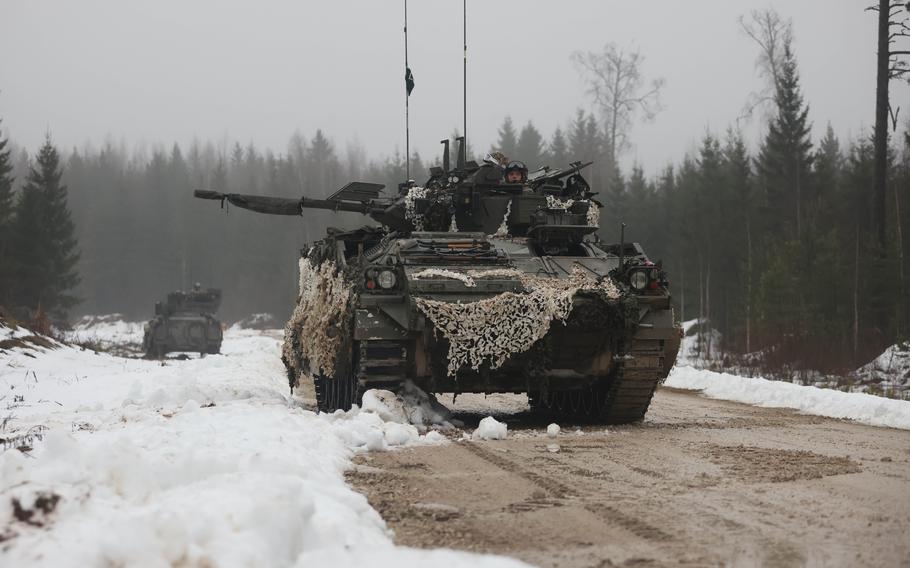
Defense Secretary Pete Hegseth speaks at a Pentagon town hall Feb. 7, 2025. Hegseth will travel to Europe to attend the NATO defense ministers meeting Thursday in Brussels. (Madelyn Keech/U.S. Air Force)
STUTTGART, Germany — The U.S. military’s role in Europe will be at the forefront of talks this week as new Defense Secretary Pete Hegseth arrives in Brussels for two days of meetings with European allies.
Uncertainty about President Donald Trump’s plans for the U.S. European Command mission has allies considering the ramifications of potentially deep cuts. Changes could be in store for defense spending, the war in Ukraine and American troop levels on the Continent.
Gatherings of the Ukraine Defense Contact Group on Wednesday and allied defense chiefs on Thursday will be followed by a meeting over the weekend in Germany, where Vice President JD Vance will lead an American delegation at a premier global defense forum, the annual Munich Security Conference.
Former top U.S. military commanders say the key to any new approach will hinge on finding a way to ensure that enough American firepower remains in Europe to dissuade Russia from expanding its war beyond Ukraine.
“(The Trump administration) will shift some forces, I’m sure, to the Pacific theater,” said James Foggo, a retired four-star admiral who previously served as the top U.S. naval commander in Europe. “But how fast and how soon will the cuts be? Will it be gradual? Will you notice? Or will it hurt?”

Retired Adm. James Foggo, former commander of naval forces in Europe, speaks at the Naval Warfare Development Center in Norfolk, Va., Aug. 11, 2023. Foggo said the Trump administration should not rush a withdrawal of troops from Europe while shifting focus to the Pacific. (Theodore Green/U.S. Navy)
Hegseth’s Pentagon is being filled out with a team of China hawks who have argued that the United States is spread too thin.
They assert that the U.S. cannot credibly deter China in the Pacific while also underwriting the bulk of the security in Europe.
“We need to grapple with scarcity,” Elbridge Colby, nominated to serve as a top deputy to Hegseth in the Pentagon, told Stars and Stripes in May. “We don’t have a two-war military. We’re not even sure if we have a one-war military, vis-a-vis China.”
In Europe, there are questions about the durability of a U.S. military presence that has served as the centerpiece of NATO’s efforts to deter Russian aggression.
There also are doubts about Europe’s ability to immediately fill the void. Years of underinvestment have left it lacking capabilities ranging from air defense and artillery to airlift, ammunition stockpiles and heavy maneuver.
When asked late last month about news reports that the U.S. was looking to pull up to 20,000 troops from Europe, the Pentagon said Hegseth is reviewing the military’s force posture.
“That means taking a hard look at where our forces are stationed and making sure they are in the right places, with the right capabilities, to meet today’s challenges,” spokesman Lt. Col. Charlie Dietz said in a Jan. 30 statement.
It remains to be seen how that plays out in Europe, where a combination of 65,000 permanently based troops and a rotational contingent add up to about 100,000 uniformed personnel overall.
Foggo, the dean of the Center for Maritime Strategy at the Navy League, said President Joe Biden’s “absolute debacle” of a withdrawal from Afghanistan should serve as a lesson for any planner considering a large and rapid drawdown in Europe.
“Some would say it’s apples and oranges, that Afghanistan is not downsizing in Europe,” Foggo said. “That’s not the point. The point is the Afghanistan withdrawal suffered by not having a plan that was any good. So if we’re going to pull forces out of Europe, we need to do it incrementally, deliberately, in collaboration with the allies.”
That means ensuring that allies are in a position to fill capability gaps to deter Russia, he said, adding that “if they don’t like it, you might have to strong-arm them a little bit.”

Retired Gen. Ben Hodges, former commander of U.S. Army Europe, speaks to soldiers in Nashville, Tenn., Feb. 3, 2023. A major U.S. troop withdrawal in Europe would put long-term American interests at risk and hinder NATO efforts to deter Russia, Hodges said. (Dani Debehets/U.S. Army)
Ben Hodges, a former commander of the U.S. Army in Europe, argues that there are risks to a singular Pacific approach that involves disengaging from Europe.
“You cannot defend America from Fort Bragg and Fort Hood,” he said, referring to a base in North Carolina and another in Texas that was renamed Fort Cavazos.
“You have to be forward-deployed so that you have the power projection capabilities, the intelligence networking that we have with all of our European allies and relationships that allow rapid reinforcements (in conflict).”
The Pentagon’s force review is occurring against a backdrop of expectations of big increases in allied defense spending. Frustration over laggard military investments was one reason Trump sought to pull 12,000 troops out of Germany during his first term.
For decades, there has been back-and-forth about troop levels in Europe. Prior to 2014, when Russia first invaded Ukraine, the American military was quickly drawing down on the Continent, with the last of the Army’s battle tanks returning to the U.S. in 2013.
“This is what failed deterrence looks like, because it all happened after we got rid of our last tanks and Apaches,” Hodges said of the Russians’ 2014 armed takeover of Crimea and other instances of the Kremlin’s use of military force.
“We were so busy downsizing we did nothing while they invaded Georgia in (2008),” Hodges added. “We did nothing after they invaded Ukraine the first time. We did nothing after they jumped over (President Barack) Obama’s red line in Syria. Then they saw our terrible withdrawal from Afghanistan.”

British forces patrol in a Warrior 510 combat vehicle while training with U.S. soldiers during a NATO exercise near Camp Tapa, Estonia, Jan. 29, 2025. The future of the American military presence in Europe will be under a microscope this week during Defense Secretary Pete Hegseth's visit to Brussels and Vice President JD Vance's trip to Germany for the annual Munich Security Conference. (Kourtney Nunnery/U.S. Army)
The cumulative effect of such missteps was likely interpreted by Russian President Vladimir Putin as an invitation to launch the full-scale invasion of Ukraine in 2022, Hodges said.
“You can almost imagine the Kremlin saying, ‘OK, these guys are not going to do anything. They don’t have the capability anymore. Let’s go finish the job in Ukraine,’” he said.
In European capitals, there is growing realization that militaries must invest much more and move with greater speed to build up capabilities now provided by the United States.
However, security analysts say it could take them several years to catch up even though defense spending levels have increased dramatically over the past decade. Whether that fits into potential Pentagon drawdown timelines isn’t clear.
The mismatch between Europe’s wealth and the relative weakness of many militaries on the Continent has fueled Trump’s attacks on NATO, which he has characterized as a collection of security freeloaders.
Hodges and Foggo argue that while it’s right to pressure allies to do more, the U.S. shouldn’t lose sight of its own global strategic interests.
“We’ve had a footprint in Europe for over 100 years, and every time we departed, we’ve had to go back,” Foggo said.